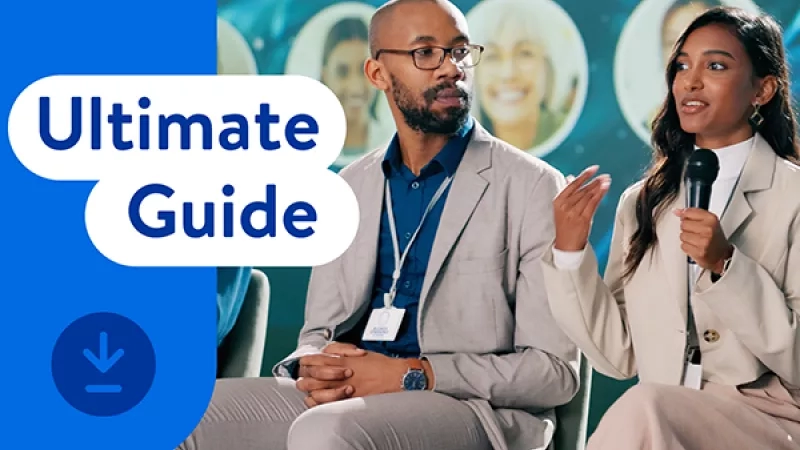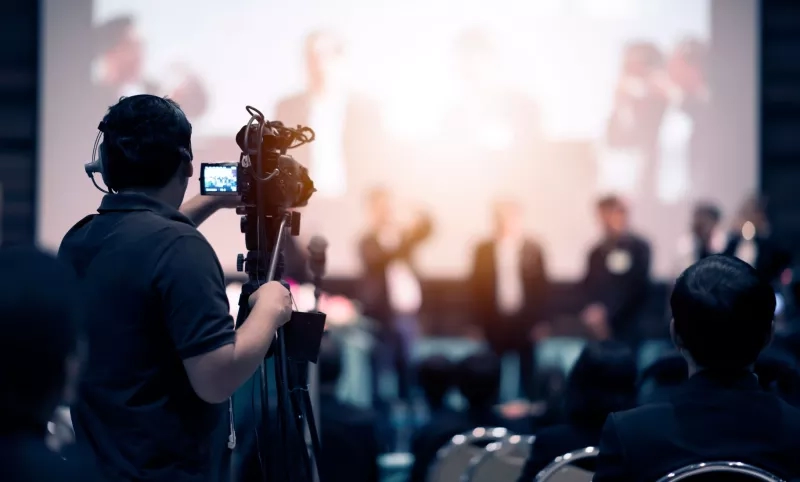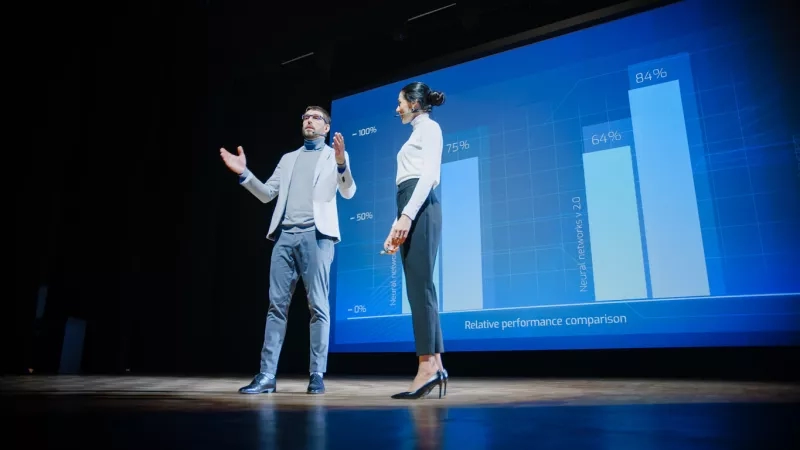A great event deserves a great stage. That's because your stage is more than just a presenter's platform. It's the focal point that brings together your event's theme, aesthetics, and overall mood. When done right, it can leave a lasting first impression and define how your audience feels about your event.
No matter how big or small the in-person or hybrid event is, it is essential to consider all the factors influencing an event's stage design. For that, you don't need to hire a fancy stage designer. Mastering the basics of production design is enough.
Here's a guide to creating a great event stage that supports your marketing goals and leaves your audience in complete awe. But first things first, what does event stage design mean?
What is an Event Stage Design?
Event stage design is the product elements you add to the presentation space to highlight the aesthetic of your in-person events. These can be lighting, backdrop, furniture, décor, AV, banners, and props.
Such wide-ranging elements can help you make a statement with your event stage while mesmerizing your attendees. Complement your designs across your event venue, such as breakout sessions or create an entirely new space—it all depends on you and your budget.
How to Choose an Event Stage Design
Your event stage design will set the tone for your entire event, giving you the opportunity to expand on your event themes, create a striking visual experience for attendees, and ensure your event program goes off without a hitch. Of course, there are many elements that will impact the success of your event, but if your stage design is a hit, you'll increase your chances of maximizing attendee engagement.
Take, for example, the 94th edition of the Oscars, held in the Dolby Theatre. The stage, designed by David Korins, featured 90,000 Swarovski crystals, a futuristic Orb, two floating domes, a swirling design, and LED lights for an optical illusion of depth and shape.
According to Korins, the design was bold, modern, positive, and immersive and tied into the event's theme of "movie lovers unite."
This example may be a stretch since it requires millions of dollars, but it underscores the key considerations when creating an event stage—your theme, venue, audience, event goals, and budget. Let's look at these factors, and how they will impact your event stage design, in more detail.
1. Finalize Your Event Theme
Your event theme is like clothes for your stage design. It dictates how you "dress up" the stage. Think about it. You wear a formal suit or dress at weddings. But if you are heading to the gym, you wear activewear.
It's the same with the event theme. If you plan to host a Ted Talk-style presentation, you would want a prominent stage, enough screen space, and professional lighting fixtures. And if it is a gala dinner, you may go for more grandeur, with detailed stage props, a flashy focal point like a disco ball, interesting lighting effects, and appropriate branding.
Similarly, the setting has to be somber if it's a summit against a pressing issue such as climate change. You don't want a flashing light show or a disco ball on the stage while introducing your keynote speaker.
In a nutshell, when deciding on your stage design, ensure it facilitates and complements your event theme without confusing attendees or creating an atmosphere that's counter to your event goals.
2. Find the Right Event Venue
If there is one thing that should decide your event stage design, it is the event venue. Things like the stage size,seating layouts and room capacity, and the total number of screens influence how the stage is designed.
But finalizing stage design and the venue is like a chicken and egg situation. If you have already decided on your stage, you need to look for a space that can accommodate your requirements. If you have selected the venue, you must consider its limitations before incorporating your event stage ideas.
While we don't want to sound like party poopers, it's best to list the things you want based on your event theme, find different venues using platforms like Cvent Supplier Network, and strike a balance. See which ones can accommodate most of your requirements, and then start turning your marvelous stage ideas into a reality.
3. Keep Your Audience in Mind
A positive attendee experience is the number one goal of most planners—it's an important part of the broader event ROI calculation. Knowing your audience's preferences, likes and dislikes, industries, etc. is essential. As a discerning event organizer, you already know this too well. However, this bears repeating for the sake of clarity, especially when striving to create a better event stage design.
Based on your understanding, anticipate what your attendees like about your events and why they're attending a specific event, and build the stage that will bring them joy (and keep them interested). For example, young music lovers might appreciate strobe lights, while a more mature audience may find them distracting.
It's always good to conduct event surveys to understand attendee preferences to make sure you're taking a pulse and responding to positive or negative feedback.
4. Understand Your Event Goals
While designing your event stage, keep your event goals in mind. For instance, if you are conducting a networking session, set up lounge areas or spaces where attendees can easily interact. If you intend to seek sponsorship for your event, you could prioritize exhibitor booths. The right stage design ideas could help you attract multiple sponsors, giving you enough opportunities to monetize your events.
Though not exactly an overarching event goal, every planner strives to stay within budget and prove the ROI of their events. Your budget will naturally be a consideration while planning your event stage design, but keep the attendee experience in mind at all times.
For many planners, paying more for their ideal event setup or venue is worth it if it means they don't have to sacrifice the attendee experience. Even as rising event costs remain a major concern for planners,61% say they look for cost savings in areas that will not diminish the attendee experience.
What Makes a Good Stage Design?
A great event stage design is a harmony of different items and the overall layout. It includes various aspects, such as:
Stage Shape: the stage's outline, items, and extras.
Mass: The weight and size of items on the stage. Mix these up to provide visual interest.
Composition: How do you place different items on the stage? It could either lead the eye to a unique object or stop it completely.
Texture: What will be the visual appeal of the items on the stage? This could be pebbled, silky, shiny, etc.
Color: The color can be of the item or the lights on the stage. Match it with your brand to create a more unified experience.
These aspects are guided by the basic principles of design, which include:
- Balance
- Unity
- Variety
- Harmony
- Movement
- Emphasis
Just as it sounds, balance means that everything on the stage has an opposite item that counteracts and magnifies each other—for instance, fire and ice.
Unity is another principle that unites all the components into the theme. However, these items are not similar to each other and add a variety to the composition. For instance, if you use balls or cubes on the stage, having all of them of the same size, color, texture, or weight won't add any visual interest. They need to be different yet similar at the same time.
Harmony brings a sense of order. While mass chaos may seem exciting, it can confuse the audience. All the elements on the stage must be in sync with each other.
Movement can be both literal and figurative. You can have moving objects on the stage or create an optical illusion that creates visual interest and keeps all eyes on the sage.
Emphasis is the place on your stage where you want the maximum attention. The most common example is a spotlight. A stage should have emphasis to avoid confusion.
Now that you know the different aspects and design principles, it is time to put them to use.
What Does Event Stage Design Include?
Screens
Screens play an essential part in a custom set. It has multiple purposes—branding, displaying the presenter's slides, or playing video and camera feeds. They can also be used as an artistic element to display content that is the same, independent of each other, or together as a fractured "canvas."
Choose one or multiple screens based on the size of your stage and place them in places where audiences can easily see.
Lighting
Lighting is more than just effects, highlights, or colors. It can be the main feature of your set design.
For instance, you can use dozens of lighting panels around your custom design set. When the lights are off, they will look like simple black bars, but when you turn them on, they act together to create a striking visual effect of objects pulsing or swirling. Wash the stage with different lighting fixtures or create animation, the choice is yours.
Pro tip: Ensure enough electrical outlets and locations when designing your event stage layout. Knowing it will help you allocate enough space for equipment and see if you can plug in all of them.
Technology
A great event stage design requires different technologies to work together. Whether it is simple mics, lights, or fog machines, it must be a significant consideration during the design process.
For example, you can use a tech-enabled banner to transform the look and feel of your event stage design. Alternatively, you can use wide digital banners to display content like hype previews, music videos, and event promotions. Such screens and banners can engage attendees and leave a memorable impression due to their visual impact.
Platforms and Walking Areas
If your event space includes a simple fixed stage area, there's not much to consider in terms of the layout or shape of your stage. However, if there's room to build a modular stage or incorporate different platforms or walkways for speakers to roam about the stage, consider how you want these elements set up to achieve the best flow for presenters and visibility for attendees.
Furniture
The focus of your event or sessions will determine what furniture—if any—you need on stage. Hosting a panel? You'll likely want enough chairs for everyone, and you may consider a table for all of the panelists to sit at so you can include waters, name placards, and perhaps table mics for each speaker.
If you're hosting a more lecture-style session, perhaps a lectern is appropriate. Want a more casual setup for a Q&A session? Set up couches for your moderator and speaker(s). The possibilities are endless, but your furniture choices will come down to the goal of your event or session and how you want your presenters and speakers to interact with others on stage and the audience.
Decor and Props
Decor and props are a great way to liven up an event stage, make speakers more comfortable, and keep attendees' attention on the stage—even if they aren't always 100% focused on your speaker. Depending on the goal and theme of your event or session, you might include decorative elements like plants, coffee tables, hanging foliage or garlands, accent lights, partitions, draped fabrics, balloons, etc.
Any props you incorporate into your stage design should be thoughtfully considered based on your session programming. Each prop should serve a purpose, and speakers or on-stage participants should have cues that tell them when and how to use each prop during their time on stage.
6 Stage Design Themes
1. Futuristic and Forward
The futuristic and forward theme gives the audience a peak into the future. Think of the Academy Awards 2022 state-of-the-art stage design, with orbs and crystal curtains. Your audience will feel excited, intrigued, inspired, and curious.
Elements of this theme:
- LED and kinetic lighting. Kinetic lighting is also known as moving lighting.
- Unique shapes of the dais and lighting design
- Textures and designs that evoke a forward and futuristic feeling
2. Modern Silicon Valley
This theme entails slick and chic designs to allow the audience to focus on the presenter. It is minimal, contemporary, clean, uncluttered, and bold. It evokes the feeling of curiosity, engagement, clear-minded, and immersion.
Elements of this theme:
- Large projections and modern stage furniture
- AV drop
- LED walls
- Clean, defined lines
- Minimum stage set pieces
3. Fresh and Natural
A fresh and natural theme includes an intimate, cozy space that fosters communication. This theme is designed to make your audience feel light, relaxed, and peaceful.
Elements of this theme:
- Greenery and natural lighting
- Organic stage elements such as plants, wood, and fabrics
- Living room-style furniture with natural imagery, which can be either printed or projected
4. Dramatic
One of the main elements of the dramatic theme is its impactful, theatrical, and grand presentation. This theme borrows heavily from the theatre world to evoke admiration, suspense, esteem, and curiosity.
Elements of this theme:
- Bold uplighting and drape
- Huge LED wall
- Ceiling lighting and dramatic pillars
- Projection screens around the room
- Modular tiles
5. Zesty Personality
Driven by a theme, this design stage reflects the personality of your brand to create a unique experience. It evokes feelings such as fun, warmth, humor, and excitement. Such designs are light-hearted and unique to your brand's voice and personality.
Elements of this theme:
- Large stage props
- LED backdrop
- Ceiling lightings
- Bold, colorful lighting (or kinetic lights)
- Stretch shape fabric
6. Industrial
The industrial stage theme features different mechanical and industrial materials and textures to evoke a feeling of resourcefulness, determination, scale, and efficiency.
Elements of this theme:
- Truss
- Metallic textures or materials like rods and pipes
- Pillars of either modular tiles or truss
- Furniture that aligns with industrial designs
Pro Tip: Even though these are the most common event stage design themes, it is best to use what's around if you are on a tight budget. Let the space speak for itself and use whatever is available—appearance, practicality, or both.
Your venue might already have a lot of props and materials to help you build a stage design. It's all about looking hard enough.
For instance, find focal points in indoor spaces, whether it is an exciting pendant light or a beautifully carved wood trim.
Lights, Camera, Action
With all the eyes on your stage, don't let it down with a mediocre design. Your event stage is like a blank canvas that you can paint according to your theme, brand, and goals. A carefully designed stage transforms the venue's overall look while ensuring that the presenters and attendees are immersed in an unforgettable experience.
Without careful consideration of important elements like LED backdrops, lights, and stage layouts, your big splurge on the perfect venue and stage setup might fail to bring the return you hope for.
Want some help visualizing your event stage design? Event design software can help you understand how your design will look and turn your stage design ideas into reality.








